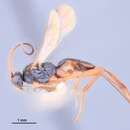Distribution
provided by Catalog of Hymenoptera in America North of Mexico
Maine, N. Y., Ont.
- bibliographic citation
- Catalog of Hymenoptera in America North of Mexico. 1979. Prepared cooperatively by specialists on the various groups of Hymenoptera under the direction of Karl V. Krombein and Paul D. Hurd, Jr., Smithsonian Institution, and David R. Smith and B. D. Burks, Systematic Entomology Laboratory, Insect Identification and Beneficial Insect Introduction Institute. Science and Education Administration, United States Department of Agriculture.
Comprehensive Description
provided by Smithsonian Contributions to Zoology
Orgilus dissidens
From tersus, new species, which it closely resembles structurally, this form may be distinguished at once by its black abdomen, and from dolosus, new species, which is even more similar, by its more slender abdomen and smoother mesonotum and mesopleuron.
FEMALE.—Length 3.5 mm. Head a little wider than thorax, in dorsal view 0.65 as long as wide; face 1.2 times as wide as eye height, finely punctate on an alutaceous ground; malar space longer than clypeus and fully half as long as eye height, granulose and dull; cheeks also finely granulose and dull; temples about 0.8 as wide as eyes, slightly receding, smooth and polished adjacent to eyes but broadly shagreened toward occipital margins; occipital carina narrowly interrupted medially; ocelli small, the ocellocular line three times as long as diameter of an ocellus; vertex smooth and shiny; antennae of holotype 31-segmented, some segments in apical third of flagellum as wide as long.
Mesoscutum shiny, and smooth except for some very shallow punctures on the middle lobe and a few on the lateral lobes near the notauli; notauli sharply impressed and foveolate; disc of scutellum convex, smooth, and shiny; propodeum dorsally rugulose except for a smooth and polished transverse area each side of the middle at base, the posterior declivity largely shiny and with rather prominent stubs of longitudinal carinae setting off the apical areas; side of pronotum closely rugulose; mesopleuron smooth and polished, the longitudinal furrow rather coarsely foveolate; metapleuron strongly rugose on posterior half, finely granulose and subopaque in the basal angle. Hind coxa rugulose on dorsal edge, finely granulose or shagreened and somewhat dull on upper part of outer side; hind femur nearly five times as long as wide but not quite twice as long as hind coxa; inner calcarium of hind tibia slightly more than half as long as metatarsus; tarsal claws simple. Radial cell on wing margin as long as stigma, the latter not angled at origin of radius; second abscissa of radius on a line with intercubitus; stub of third abscissa of cubitus fully as long as second abscissa; nervulus a little postfurcal; hind wing about 4.5 times as long as wide; lower abscissa of basella slightly longer than nervellus but less than half as long as mediella.
Abdomen slender, narrower than thorax, first tergite about 1.5 times as long as wide at apex, closely and finely longitudinally rugulose, the spiracles twice as far from apex as from base, the dorsal keels not developed; second tergite about as long as broad at base, parallel-sided, finely longitudinally rugulose punctate on basal two-thirds except for the smooth and shiny lateral margins; remainder of abdomen smooth and shiny; the second suture very weak; ovipositor sheath about as long as propodeum and abdomen combined.
Black; clypeus reddish yellow anteriorly; mandibles yellow; palpi rather piceous; scape of antenna largely dark but light brown below; flagellum brownish yellow above as well as below on at least basal half, darkened apically; tegulae and wing bases yellow, wings slightly infumated; legs yellowish brown, the hind coxae basally and the hind tibiae apically a little darkened; basal abdominal sternites yellow.
MALE.—Unknown.
HOLOTYPE.—USNM 70159.
DISTRIBUTION.—Known only from the type-series consisting of three females: The holotype from Mt. Katahdin, Maine, 5215 feet, collected 19 August 1902; one paratype taken near Ithaca, New York, 14 July 1951, by J. C. Martin, and a second paratype collected at Chatterton, Ontario, 6 June 1956, by Martin.
- bibliographic citation
- Muesebeck, Carl F. W. 1970. "The Nearctic species of Orgilus Haliday (Hymenoptera: Braconidae)." Smithsonian Contributions to Zoology. 1-104. https://doi.org/10.5479/si.00810282.30

